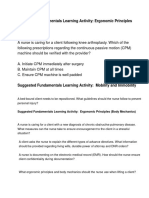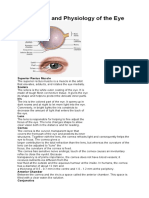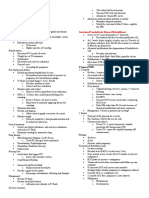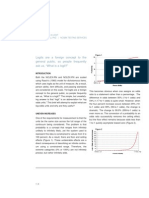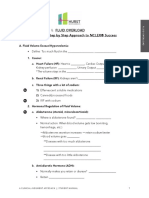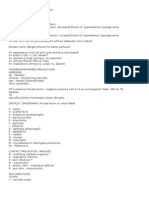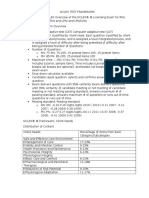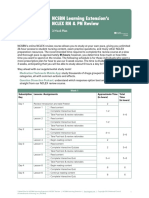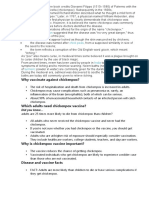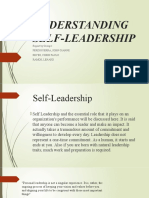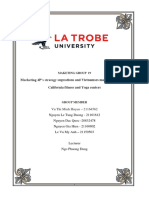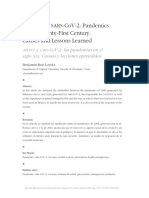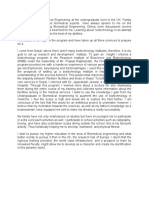Anatomy and Physiology of The Ear
Anatomy and Physiology of The Ear
Uploaded by
Gunel AliyevaOriginal Description:
Original Title
Copyright
Available Formats
Share this document
Did you find this document useful?
Is this content inappropriate?
Report this DocumentCopyright:
Available Formats
Anatomy and Physiology of The Ear
Anatomy and Physiology of The Ear
Uploaded by
Gunel AliyevaCopyright:
Available Formats
Anatomy and Physiology of the Ear
The ear is the organ of hearing and balance. The parts of the ear include:
External or outer ear, consisting of:
o Pinna or auricle. This is the outside part of the ear.
o External auditory canal or tube. This is the tube that connects the
outer ear to the inside or middle ear.
Tympanic membrane (eardrum). The tympanic membrane divides the
external ear from the middle ear.
Middle ear (tympanic cavity), consisting of:
o Ossicles. Three small bones that are connected and transmit the sound
waves to the inner ear. The bones are called:
Malleus
Incus
Stapes
o Eustachian tube. A canal that links the middle ear with the back of
the nose. The eustachian tube helps to equalize the pressure in the middle
ear. Equalized pressure is needed for the proper transfer of sound waves. The
eustachian tube is lined with mucous, just like the inside of the nose and throat.
Inner ear, consisting of:
o Cochlea. This contains the nerves for hearing.
o Vestibule. This contains receptors for balance.
o Semicircular canals. This contains receptors for balance.
How do you hear?
Hearing starts with the outer ear. When a sound is made outside the outer ear, the
sound waves, or vibrations, travel down the external auditory canal and strike the
eardrum (tympanic membrane). The eardrum vibrates. The vibrations are then
passed to 3 tiny bones in the middle ear called the ossicles. The ossicles amplify
the sound. They send the sound waves to the inner ear and into the fluid-filled
hearing organ (cochlea).
Once the sound waves reach the inner ear, they are converted into electrical
impulses. The auditory nerve sends these impulses to the brain. The brain then
translates these electrical impulses as sound.
How the Ear Works
Understanding the parts of the ear — and the role of each in processing sounds —
can help you better understand hearing loss.
The Outer Ear
The auricle (pinna) is the visible portion of the outer ear. It collects sound waves
and channels them into the ear canal (external auditory meatus), where the sound is
amplified.
The sound waves then travel toward a flexible, oval membrane at the end of the ear
canal called the eardrum, or tympanic membrane. Sound waves cause the eardrum
to vibrate.
The Middle Ear
The vibrations from the eardrum set the ossicles into motion. The ossicles are
actually tiny bones — the smallest in the human body. The three bones are named
after their shapes: the malleus (hammer), incus (anvil) and stapes (stirrup). The
ossicles further amplify the sound.
The tiny stapes bone attaches to the oval window that connects the middle ear to
the inner ear. The Eustachian tube, which opens into the middle ear, is responsible
for equalizing the pressure between the air outside the ear and that within the
middle ear.
The Inner Ear
The sound waves enter the inner ear and then into the cochlea, a snail-shaped
organ. The cochlea is filled with a fluid that moves in response to the vibrations
from the oval window. As the fluid moves, 25,000 nerve endings are set into
motion. These nerve endings transform the vibrations into electrical impulses that
then travel along the eighth cranial nerve (auditory nerve) to the brain.
The brain then interprets these signals, and this is how we hear.
The inner ear also contains the vestibular organ that is responsible for balance.
You might also like
- The Nursing School Complete Bundle - Stephanee Beggs - 2021 - RNEXPLAINED INC - Anna's ArchiveDocument291 pagesThe Nursing School Complete Bundle - Stephanee Beggs - 2021 - RNEXPLAINED INC - Anna's ArchivePeoplesmother123No ratings yet
- Guyana Diabetes Guidelines 26-Jun-23 FinalDocument20 pagesGuyana Diabetes Guidelines 26-Jun-23 FinalnathanielNo ratings yet
- The Sage Handbook of Organizational WellbeingDocument22 pagesThe Sage Handbook of Organizational WellbeingSamungateNo ratings yet
- Pharmacology Test 3 ReviewDocument6 pagesPharmacology Test 3 ReviewNatalia BortellNo ratings yet
- Banana Peal FeasibDocument104 pagesBanana Peal Feasibjolina100% (3)
- Fatime Sanogo Vsim Steps - HTMLDocument6 pagesFatime Sanogo Vsim Steps - HTMLJhunnieEy ReyesNo ratings yet
- Fundamental QuestionsDocument5 pagesFundamental QuestionsSheshe0% (3)
- Transition Care PlanDocument5 pagesTransition Care PlangyanendraNo ratings yet
- ISBAR Worksheet Olivia Jones Jasgou1752Document1 pageISBAR Worksheet Olivia Jones Jasgou1752Jasmyn Rose100% (1)
- Ati RN 2016 Mental HealthDocument6 pagesAti RN 2016 Mental HealthStan Tan0% (1)
- Anatomy and Physiology of The EyeDocument2 pagesAnatomy and Physiology of The EyeKeanu Jay MaltosNo ratings yet
- Hematologic System2Document70 pagesHematologic System2Jesus Mario LopezNo ratings yet
- ATI Lab ValuesDocument4 pagesATI Lab ValuesWhite BoiNo ratings yet
- Cardiovascular & Hematologic SystemDocument163 pagesCardiovascular & Hematologic SystemRellie CastroNo ratings yet
- Hyperemesis Gravidarum: Bleeding Complications of PregnancyDocument6 pagesHyperemesis Gravidarum: Bleeding Complications of PregnancykirbsNo ratings yet
- Endocrine 10-Day Post Live ModulesDocument15 pagesEndocrine 10-Day Post Live ModulesPascal St Peter Nwaorgu100% (2)
- Nursing Fundamentals PracticeDocument10 pagesNursing Fundamentals Practicekirby xxNo ratings yet
- Nervous SystemDocument23 pagesNervous SystemAlliyah SalindoNo ratings yet
- Fluids and Electrolytes: Irene L. Gardiner, MDDocument48 pagesFluids and Electrolytes: Irene L. Gardiner, MDGabriel Carlo FranciscoNo ratings yet
- NCLEX-RN - Definition of LogitDocument3 pagesNCLEX-RN - Definition of LogitPhilippineNursingDirectory.comNo ratings yet
- Muscoskeletal DisordersDocument17 pagesMuscoskeletal DisordersAntonio Andag SalasNo ratings yet
- Draft: Jurisprudence Learning Module & ExaminationDocument45 pagesDraft: Jurisprudence Learning Module & ExaminationDeepanshi RajputNo ratings yet
- Drugs Acting On GitDocument119 pagesDrugs Acting On GitNathaniel Mbiu Tim100% (1)
- Autonomic Nervous SystemDocument16 pagesAutonomic Nervous SystemmogibsfNo ratings yet
- Med Surg 2 - 10 Nursing Care of Clients With Biliary DisordersDocument4 pagesMed Surg 2 - 10 Nursing Care of Clients With Biliary DisordersMaxinne RoseñoNo ratings yet
- 6 - FTT & FAS - MergedDocument25 pages6 - FTT & FAS - Mergedrenie3245No ratings yet
- Ati PN Adult Medical Surgical Proctored 2023 Newest Exam Version 1Document76 pagesAti PN Adult Medical Surgical Proctored 2023 Newest Exam Version 1iannyaga450No ratings yet
- Pharmacology Bundle Study GuideDocument47 pagesPharmacology Bundle Study GuideAmisalu Nigusie100% (1)
- NursingCalculations Formulas PDFDocument1 pageNursingCalculations Formulas PDFMaha J. M.No ratings yet
- Med Surg Success 3e A Q A Review Applying Critical... Chapter 3 Cardiac Disorders PDFDocument40 pagesMed Surg Success 3e A Q A Review Applying Critical... Chapter 3 Cardiac Disorders PDFneah1987No ratings yet
- 2022 Communicable Disease Reference Guide For SchoolsDocument118 pages2022 Communicable Disease Reference Guide For Schoolsmohan s vNo ratings yet
- Cardiovascular System Drugs - Active Stack® Pharmacology Flash Cards - Study Materials - My ATIDocument1 pageCardiovascular System Drugs - Active Stack® Pharmacology Flash Cards - Study Materials - My ATIAntonette Joy SolinapNo ratings yet
- AdultDocument295 pagesAdultKen WonNo ratings yet
- Nursing DiagnosisDocument48 pagesNursing DiagnosisLydia Lopz MsnrncdNo ratings yet
- Ch. 1, Lesson 1: What Is The Next Gen NCLEXDocument4 pagesCh. 1, Lesson 1: What Is The Next Gen NCLEXChantel100% (1)
- Health Assessment: NeuroDocument34 pagesHealth Assessment: Neuroiamjennykim76No ratings yet
- Amelia Sung MAternity VSIM Guided ReflectionDocument2 pagesAmelia Sung MAternity VSIM Guided Reflectionmeisha thompsonNo ratings yet
- CH 18 Endo F 2017Document152 pagesCH 18 Endo F 2017Julia100% (1)
- Endocrine SystemDocument21 pagesEndocrine SystemMark DimarucutNo ratings yet
- Physiological IntegrityDocument317 pagesPhysiological IntegrityMoreiyamNo ratings yet
- 3 2024 Infection Control Nclex RN HandoutDocument39 pages3 2024 Infection Control Nclex RN Handoutmusiddrisu470No ratings yet
- Prioritization LectureDocument6 pagesPrioritization LecturesamNo ratings yet
- BDocument118 pagesBbeautifulme031690No ratings yet
- Fluid Overload Student PagesDocument4 pagesFluid Overload Student PagesJess OswaldNo ratings yet
- Diuretics: Diuretics Are Drugs That Increase The Volume of Urine FlowDocument35 pagesDiuretics: Diuretics Are Drugs That Increase The Volume of Urine FlowAmanuel Maru100% (1)
- Blood Glucose Meter PDFDocument10 pagesBlood Glucose Meter PDFsneh1509No ratings yet
- 12 Cranial NervesDocument2 pages12 Cranial NervesJessica KruppNo ratings yet
- PharmacologyDocument9 pagesPharmacologyRPh Krishna Chandra JagritNo ratings yet
- RN Thread NclexDocument21 pagesRN Thread NclexMaria Nadia MihalikNo ratings yet
- Cardiovascular AP & Nursing AssessmentDocument24 pagesCardiovascular AP & Nursing AssessmentIssy2703No ratings yet
- Exam ReviewDocument4 pagesExam ReviewMya Thomas100% (1)
- Emergency Response CPR Burns ECG Shock and Frost BiteDocument28 pagesEmergency Response CPR Burns ECG Shock and Frost BiteYancy Rivera GoNo ratings yet
- Nursing School Study and Organization TipsDocument2 pagesNursing School Study and Organization TipsJennifer WeeksNo ratings yet
- NCLEX 15 WK 1critical ThinkingDocument2 pagesNCLEX 15 WK 1critical ThinkingNikita TamrakarNo ratings yet
- Fluid & Electrolyte ImbalancesDocument212 pagesFluid & Electrolyte ImbalancesLane Mae Magpatoc NoerrotNo ratings yet
- Framework NclexDocument7 pagesFramework NclexDefensor Pison GringgoNo ratings yet
- 3 Week Review StudyPlan PDFDocument2 pages3 Week Review StudyPlan PDFDanica Alyssa EnriquezNo ratings yet
- Brain Dump NUR 213 FINALDocument37 pagesBrain Dump NUR 213 FINALkelsey jackson100% (1)
- Nursing School BundleDocument308 pagesNursing School BundlemallorypartyrentalsNo ratings yet
- Bullets (Funda)Document23 pagesBullets (Funda)steffaguilar01No ratings yet
- Basic Care and ComfortDocument35 pagesBasic Care and ComfortRebecca TapiaNo ratings yet
- NURSING CARE OF ADULTS II: Passbooks Study GuideFrom EverandNURSING CARE OF ADULTS II: Passbooks Study GuideNo ratings yet
- Diseases of The EyeDocument14 pagesDiseases of The EyeGunel AliyevaNo ratings yet
- Health and Body Taboo Games - 24053Document1 pageHealth and Body Taboo Games - 24053Gunel AliyevaNo ratings yet
- Amazing Facts About Blood and The HeartDocument3 pagesAmazing Facts About Blood and The HeartGunel AliyevaNo ratings yet
- Why Vaccinate Against Chickenpox?: EnglishDocument2 pagesWhy Vaccinate Against Chickenpox?: EnglishGunel AliyevaNo ratings yet
- Character Formation LeadershipDocument10 pagesCharacter Formation LeadershipJohn GianneNo ratings yet
- Unit 5 Reading Quiz: Part A Key SkillsDocument3 pagesUnit 5 Reading Quiz: Part A Key SkillsYoka MionakoNo ratings yet
- MKT GROUP Assignment PDFDocument21 pagesMKT GROUP Assignment PDFBùi Thị Phương UyênNo ratings yet
- Evaluation Ayucotan I. Community Profile: Email Address: CP # 091598949379/tel# (034) 4315-255Document4 pagesEvaluation Ayucotan I. Community Profile: Email Address: CP # 091598949379/tel# (034) 4315-255Beth SaiNo ratings yet
- Legal Internship: Start-Up Initiative Learning OutcomesDocument7 pagesLegal Internship: Start-Up Initiative Learning OutcomesNancy SinghNo ratings yet
- Personal vs. Organizational Spiritual LeadershipDocument10 pagesPersonal vs. Organizational Spiritual Leadershipmahfuja miliNo ratings yet
- Daily Workout 1: Ball HandlingDocument6 pagesDaily Workout 1: Ball HandlingTVPSS SJKC CHUNG HWA JERTEHNo ratings yet
- Screenshot 2022-11-30 at 9.38.52 AMDocument1 pageScreenshot 2022-11-30 at 9.38.52 AMArt SamaniegoNo ratings yet
- Ruiz L PandemicsDocument18 pagesRuiz L PandemicsBenjamin LoyolaNo ratings yet
- Oxford Desk Reference Acute MedicineDocument851 pagesOxford Desk Reference Acute Medicinejones dondo100% (3)
- Having Trouble SleepingDocument2 pagesHaving Trouble SleepingGordanaNo ratings yet
- Documented Procedure Addresses The Prevention of Adverse Events Like Wrong Site, Wrong Patient and Wrong SurgeryDocument10 pagesDocumented Procedure Addresses The Prevention of Adverse Events Like Wrong Site, Wrong Patient and Wrong SurgeryPamukuntla MounikareddyNo ratings yet
- Response To Stress PresentationDocument27 pagesResponse To Stress PresentationMohit PunaniNo ratings yet
- SOCB58 SyllabusDocument4 pagesSOCB58 SyllabusGina DuncanNo ratings yet
- Buku Program Shmyh 20212022 Dr. AkmaDocument19 pagesBuku Program Shmyh 20212022 Dr. AkmaSITI HANIFAH BINTI MOHAMMAD KASFINo ratings yet
- Coming To Life in The Consulting Room Toward A New Analytic Sensibility by Thomas H. OgdenDocument193 pagesComing To Life in The Consulting Room Toward A New Analytic Sensibility by Thomas H. OgdenArthur Franco100% (1)
- SOPDocument1 pageSOPuday agrawalNo ratings yet
- Humss-B Marvin ManuscriptDocument35 pagesHumss-B Marvin ManuscriptAnn Catherine EcitaNo ratings yet
- Apy Dlle OgDocument11 pagesApy Dlle Ogilhanshaikh19No ratings yet
- Desta Actaped 2006 PDFDocument5 pagesDesta Actaped 2006 PDFyohanesNo ratings yet
- Health Assessment in Nursing Weber 5th Edition Test BankDocument9 pagesHealth Assessment in Nursing Weber 5th Edition Test BankMikeOsbornenjoi100% (45)
- Oxford Textbook of Palliative Social Work Oxford Textbooks in Palliative Medicine 1St Edition PDF Full Chapter PDFDocument53 pagesOxford Textbook of Palliative Social Work Oxford Textbooks in Palliative Medicine 1St Edition PDF Full Chapter PDFyirinabelohh100% (8)
- PHD Thesis On Rheumatoid ArthritisDocument7 pagesPHD Thesis On Rheumatoid Arthritispaulasmithindependence100% (2)
- Nidotherapy - Better Mental Health Through Environmental ChangeDocument6 pagesNidotherapy - Better Mental Health Through Environmental ChangeGunreddy RajareddyNo ratings yet
- Public Administration ConceptDocument9 pagesPublic Administration ConceptHezekia KiruiNo ratings yet
- Your Entire FaultDocument4 pagesYour Entire FaultBlake BrewerNo ratings yet
- Third Quarter Learning Activity Sheet in English-Week 4Document4 pagesThird Quarter Learning Activity Sheet in English-Week 4Justine Leigh FloresNo ratings yet
- The 7 Habits of Highly Effective People: Key To High-Performance OrganizationsDocument11 pagesThe 7 Habits of Highly Effective People: Key To High-Performance OrganizationsFPT100% (1)






